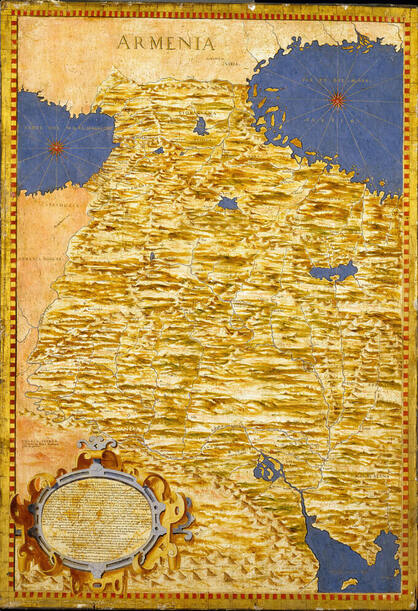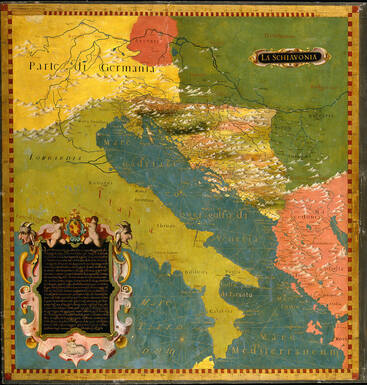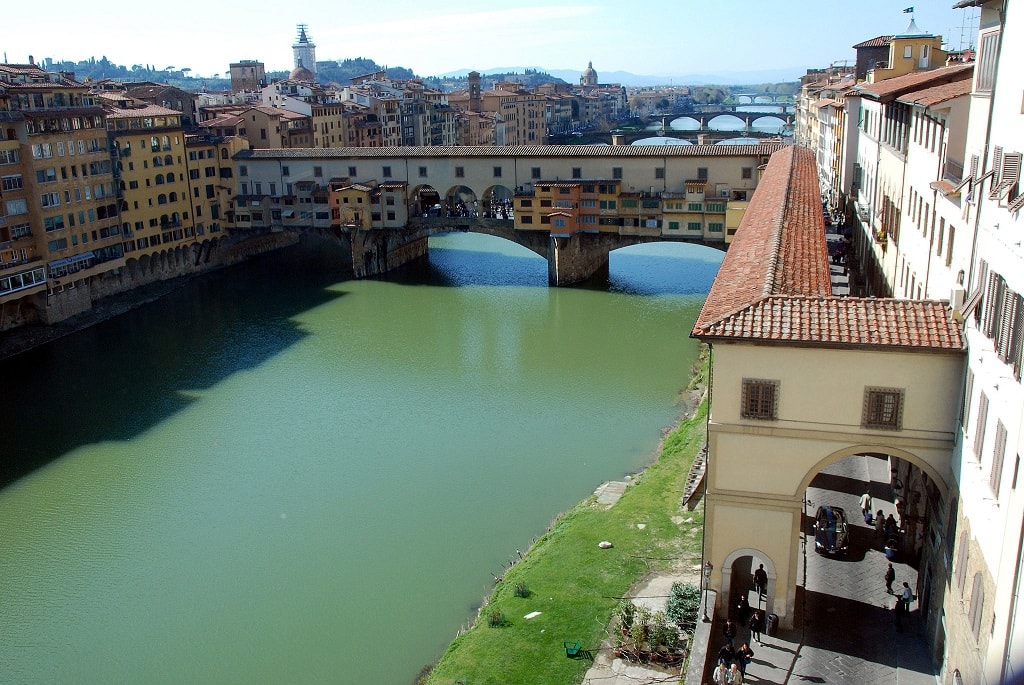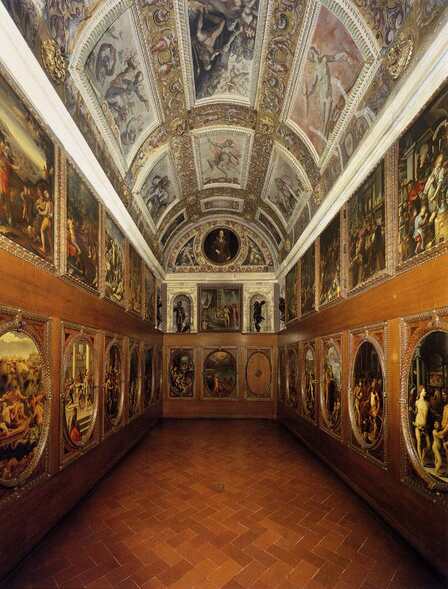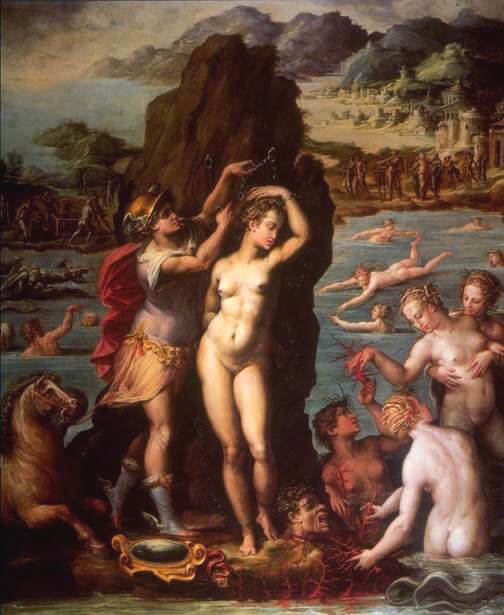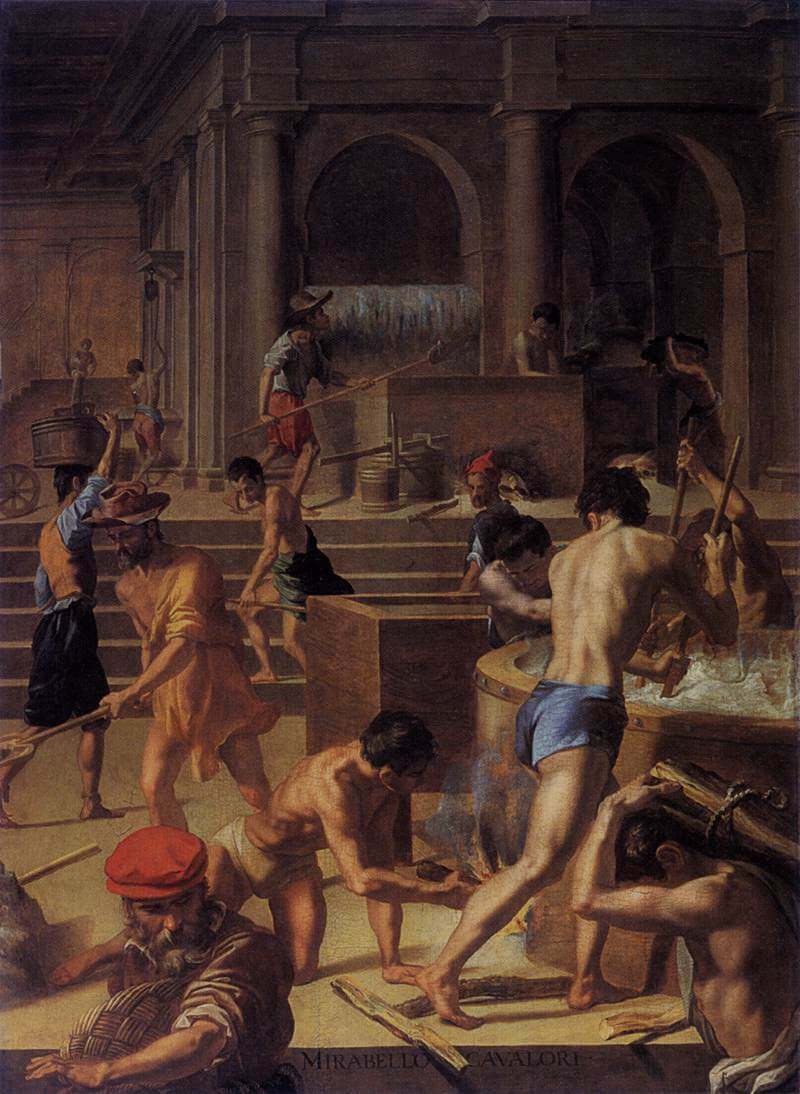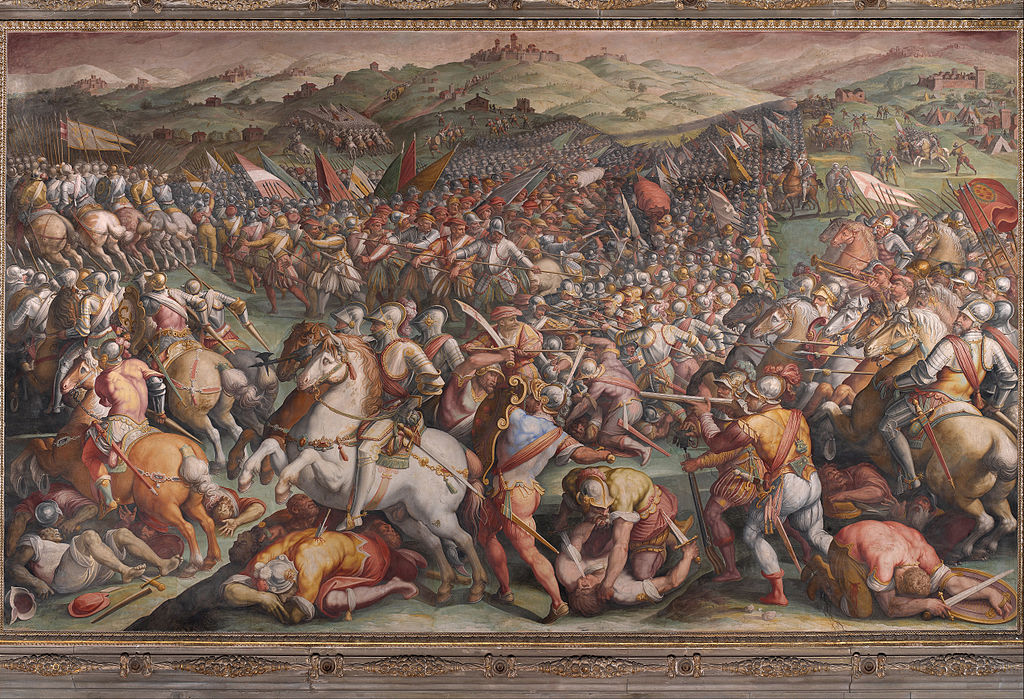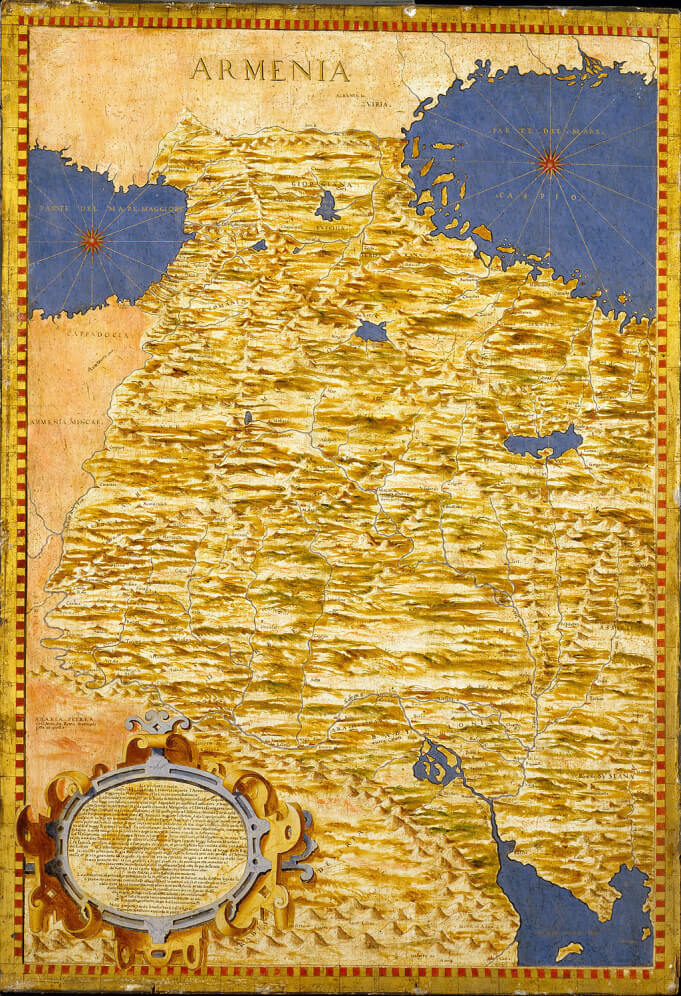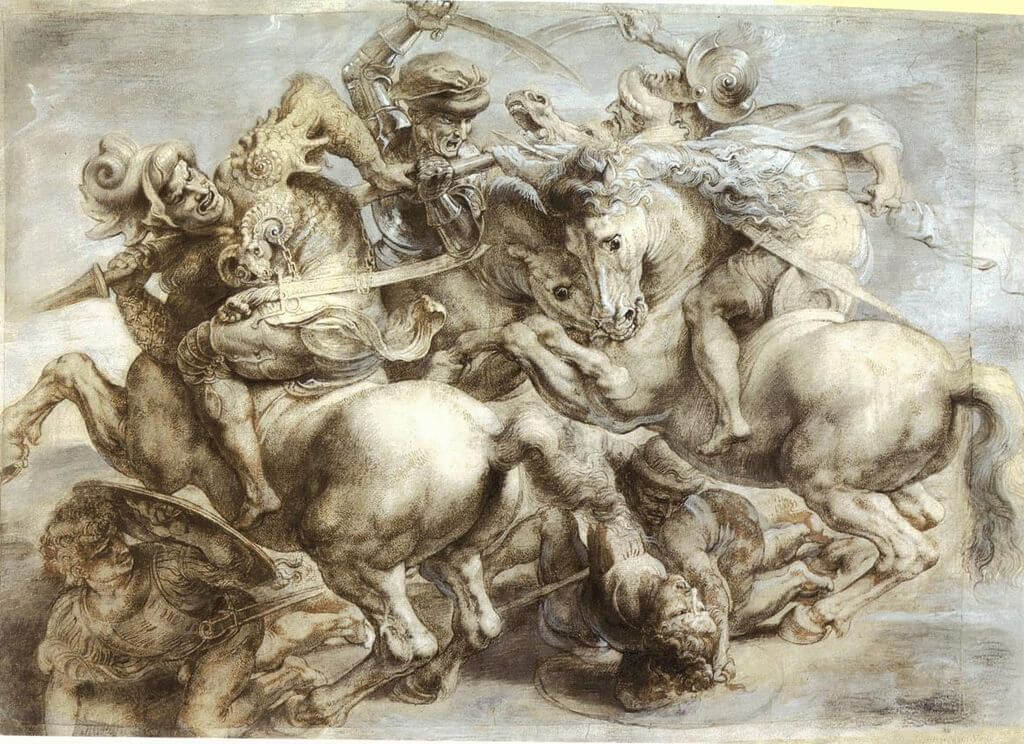|
Where? Room on the Second Floor of the Palazzo Vecchio
When? 1561-1565 Commissioned by? Duke Cosimo I de’ Medici Designed by? Giorgio Vasari designed the room in conjunction with cosmographer Fra’ Miniato Pitti. Egnazio Danti completed the painting of the map of Armenia. What do you see? This room shows the world as known in 1563. It was supposed to show both the terrestrial view (the maps of the countries in the world) and the celestial view (the map of the sky). Nowadays, this hall provides dozens of geographical maps painted on leather. The maps range from Japan to Brazil, and from the North Pole to the South Pole. More precisely, the room houses 53 maps. The first 30 have been completed by Egnazio Danti while Duke Cosimo I was still alive. After his death, the son of Cosimo I, Francesco I, hired Stefano Bonsignori to complete the remaining 23 maps. The maps are very precise, based on the knowledge of that time, and contain impressive details, including information about the wind and other typical features of each territory. In the middle of the room stands the largest rotating globe of its era, created by Matteo Neroni in 1567. Finally, the ceiling was supposed to be decorated with the 48 constellations but has never been completed.
Backstory: Duke Cosimo I de’ Medici asked Vasari to design this room that would show the whole world as known at that time. The room also contained many of the most valuable objects that the Medici family collected, stored in large cupboards made of walnut wood. These objects included scientific instruments, small statues, and tapestries. The maps were created on top of the cupboard doors. The room also served the purpose of celebrating the duke as the lord of the universe. This may be related to his name Cosimo, which was his birth name, and which was derived from the Greek word ‘kosmos’, which means 'universe'.
Who is Duke Cosimo I de’ Medici? Cosimo I de’ Medici (1519-1574) was born in Florence and was the Duke of Florence from 1537-1569, after which he became the Grand Duke of Tuscany until his death. Cosimo was part of a rich banking family that was already a political dynasty since the 14th century. Cosimo was very interested in geography, natural sciences, and trade. Like his ancestors, he was an important supporter of the development and preservation of art during his life. For example, he has given Giorgio Vasari the task to create the building of the Uffizi Museum and the Vasari Corridor. However, Cosimo also commissioned the Palazzo Pitti and the Boboli gardens.
Who is Giorgio Vasari? Giorgio Vasari (1511-1574) was an architect, historian, painter, and writer. He is best known for his book (Amazon link) describing the lives of many of the most well-known Renaissance artists. He has been instrumental in the design of the Palazzo Vecchio as we experience it today. He was involved in the design of many of the elements of the palace, including the Hall of the Five Hundred, the staircase leading up to the Hall of the Five Hundred, the Studiolo of Francesco I, and the staircase up to the second floor.
Fun fact: The Palazzo Vecchio is full of secret entrances and hidden rooms. Behind the map of Armenia, there is a secret door that leads to a private studio. This studio served multiple purposes over time. It has been used by the inhabitants of the palace to bring their lovers for some intimacy, but also to torture their enemies. The studio leads to a stairway with a small opening where corpses could conveniently be dumped in the nearby river. While these kinds of hidden studios were typically reserved for the male inhabitants, it was initially used by Duchess Bianca Cappello, the daughter-in-law of Cosimo I, who secretly married to Cosimo’s son Francesco I. Interested in a copy for yourself? A short book with illustrations from the maps in this room (Amazon link)
0 Comments
Where? A small room connected to the Hall of the Five Hundred in the Palazzo Vecchio
When? 1570-1572 Commissioned by? Francesco I de’ Medici Created by? Giorgio Vasari in collaboration with Vincenzo Borghini and Giovanni Batista Adriani What do you see? The most extravagant room in the Palazzo Vecchio is the Studiolo of Francesco I. It is completely decorated with paintings and sculptures. Most of the paintings and sculptures in this room are related to the four elements. Let’s highlight several of thes artworks in this room:
Backstory: This room was created for Francesco I de’ Medici who wanted to surround himself with the things he loved, which was pursuing his interests in chemistry and alchemy. The room was part of the private apartment of Francesco I and could be accessed only from his bedroom. That entrance was on the opposite side of the room from the current entrance, which is on the side of the Hall of the Five Hundred and did not exist around that time.
Francesco I used this room as a cabinet of curiosities to store rare items, including natural items and stones, which he collected while traveling the world. He stored this collection in about 20 cabinets that filled up the walls of the room. Each cabinet was decorated with a painting that represented what could be found inside. Unfortunately, none of these rare items has been preserved. Symbolism: The four walls of the Studiolo are associated with the four elements: air, earth, fire, and water. This theme was inspired by Francesco’s interest in nature. Each of the walls represents one theme. The wall where you enter the room represents earth and the short wall on the opposite end represents air. The wall on the left represents water and the wall on the right fire. Who is Francesco I de’ Medici? Francesco I de’ Medici (1541-1587) was the second Grand Duke of Tuscany and successor to his father Cosimo I de’ Medici. He was in charge of Tuscany from 1574-1587. Just like his father he had a great interest in art and continued to support the great artists of his time. He was also very interested in science and nature, especially alchemy and chemistry. Who is Vasari? Giorgio Vasari (1511-1574) was an architect, historian, painter, and writer. He is best known for his book describing the lives of many of the most well-known Renaissance artists (Amazon link to the book). His colleagues regarded him as a great architect. He played an important role in the design of the Hall of the Five Hundred and is also known from his design of the Vasari Corridor and the Uffizi Museum.
Fun fact: The Palazzo Vecchio has many secrets, such as hidden rooms, secret staircases, and secret spaces in the roof of the Hall of the Five Hundred. One of those secret entrances can be found in the Studiolo. The entrance from the Hall of the Five Hundred only opened in the 19th century and the original entrance is on the other side of the room (it is the panel without a painting). This secret entrance or exit leads to the bedroom of the Duke. If you are interested in these secrets, you can book a tour that covers these secret passages.
Where? Hall of the Five Hundred in the Palazzo Vecchio
When? 1565 Commissioned by? Duke Cosimo I de’ Medici What do you see? The battle of Marciano is a bloody battle between the Republic of Siena and Florence, which was won by the Florentine. In the foreground, several explicit scenes are depicted of people getting killed in man-to-man battles. The rest of the fresco shows the battle between the large armies of Florence and Siena. Backstory: This fresco is also known as the Battle of Scannogallo (which was a creek near the village of Marciano della Chiana). The fresco marks the victory of the Florentine army over the army of Siena. The Florentine army worked together with the Spanish army, while the Republic of Siena got help from the French army. Both sides had a total of about 15 thousand soldiers that day. While on the Florentine side only 200 people got killed, the Siena side suffered losses of 4,000 with an additional 4,000 people captured. Why the Battle of Marciano? The battle of Scannagallo took place on August 2, 1554. It was a battle between the Florentine army under the command of Gian Giacomo Medici (following orders of Duke Cosimo I de’ Medici) and the Siena army under the command of Piero Strozzi. The goal of Duke Cosimo I de Medici was to get complete control of Tuscany, and for that, the Republic of Siena had to be conquered. This battle was a very important event in the decline of the Republic of Siena, and in 1559 they finally surrendered to Florence. Who is Vasari? Giorgio Vasari (1511-1574) was an architect, historian, painter, and writer. The paintings in the Hall of the Five Hundred are considered to be one of his best paintings. He was also the creator of the Hall of Geographical Maps which is also in the Palazzo Vecchio. Vasari was also a very successful architect and his work includes the construction of the Uffizi Museum and the Vasari Corridor in Florence. However, he is most famous nowadays for his book e Vite de’ più eccellenti pittori, scultori, e architettori da Cimabue insino a’ tempi nostril, translated as Lives of the Most Excellent Painters, Sculptors, and Architects, from Cimabue to Our Times, which documents the history of the Italian Renaissance (Amazon link to the book).
Dan Brown: This painting plays an important role in the book Inferno by Dan Brown (Amazon link to the book). On a green flag in the top middle of the fresco the words ‘cerca trova’ are written, which means ‘seek and ye shall find’. Without binoculars, it is almost impossible to see this.
The green flags belonged to the Siena army and they used to include different verses of Dante on them for inspiration. Duke Cosimo I wanted the sentence ‘cerca trova’ to be included in the painting as an ironic reference to the ‘defeat’ that the Siena army found. In Dan Brown’s book Inferno the words ‘cerca trova’ play an important role and lead the main character Robert Langdon to the death mask of Dante. What is a Fresco? A fresco is a painting that is executed using the fresco technique. This technique paints directly on wet lime plaster (a mix of sand, water, and lime that becomes solid when it dries). After the pigment is applied to the wet plaster and the plaster dries, the painting becomes an integral part of the wall. A mural is a more general word than a fresco as murals can also be created using different techniques. Fun fact: It has long been believed by many that below the fresco of Vasari a famous fresco of Leonardo da Vinci can be found. In 1505 Leonardo da Vinci completed a fresco called The Battle of Anghiari. This fresco is referred to as the ‘lost Leonardo’ and preparatory sketches from Leonardo for this fresco and copies by later artists, such as Peter Paul Rubens, serve as evidence for the existence of this fresco. There are three reasons to believe that the lost Leonardo may indeed still be hidden here.
Interested in a copy for yourself? Poster or Canvas |
Categories
All
|
- Home
- Blog
-
Museums
- Alte Pinakothek
- Art Institute of Chicago
- Baltimore Museum of Art
- Barber Institute of Fine Arts
- Bargello
- Barnes Foundation
- British Museum
- Church of Sant’Anastasia
- Cleveland Museum of Art
- Courtauld Institute of Art
- Detroit Institute of Arts
- Frans Hals Museum
- Galleria Borghese
- Gallerie dell'Accademia
- Getty Museum
- Guggenheim
- Hermitage Museum
- Kunsthistorisches Museum
- Kunstmuseum Basel
- Legion of Honor Museum
- Louvre
- Mauritshuis
- Metropolitan Museum of Art
- Musee d’Orsay
- Museum of Fine Arts in Boston
- Museum of Modern Art
- National Gallery in London
- National Gallery of Art
- National Museum in Poznań
- Norton Simon Museum
- Ny Carlsberg Glyptotek
- Palace of Versailles
- Palazzo Pitti
- Palazzo Vecchio
- Petit Palais
- Philadelphia Museum of Art
- Prado
- Pushkin Museum
- Ravenna Art Museum
- Rijksmuseum
- San Diego Museum of Art
- Santa Maria delle Grazie
- St. Peter's Basilica
- Städel Museum
- Statens Museum for Kunst
- Tate Britain
- Tate Modern
- Timken Museum of Art
- Uffizi
- Vatican Museums
- Wallace Collection
-
Artists
- Altdorfer
- Anguissola
- Berlin Painter
- Bosch
- Botticelli
- Boucher
- Bronzino
- Bruegel the Elder
- Brunelleschi
- Cabanel
- Caillebotte
- Canova
- Caravaggio
- Carpeaux
- Cezanne
- Cimabue
- David
- Degas
- Delacroix
- De Maria
- Donatello
- El Greco
- Fontana
- Fra Angelico
- Fragonard
- Gauguin
- Gentileschi
- Gericault
- Gonzalez-Torres
- Goya
- Hals
- Hogarth
- Hokusai
- Ingres
- Leonardo da Vinci
- Lippi, Filippo
- Longhi, Barbara
- Lorrain
- Makovsky
- Manet
- Massys
- Matisse
- Merian
- Michelangelo
- Mochi
- Modigliani
- Monet
- Panini
- Parmigianino
- Perugino
- Picasso
- Pisanello
- Raphael
- Rembrandt
- Renoir
- Reynolds
- Rivera
- Rodin
- Rubens
- Scultori
- Seurat
- Steen
- Tintoretto
- Titian
- Toulouse-Lautrec
- Turner
- Uccello
- Van der Weyden
- Van Dyck
- Van Eyck
- Van Gogh
- Van Hemessen
- Vasari
- Velazquez
- Vermeer
- Veronese
- Vigée Le Brun
-
Locations
- Books
- About Us

